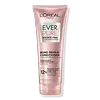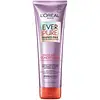What's inside
What's inside
 Key Ingredients
Key Ingredients

 Benefits
Benefits

 Concerns
Concerns

 Ingredients Side-by-side
Ingredients Side-by-side

Water
Skin ConditioningCetearyl Alcohol
EmollientGlycerin
HumectantBehentrimonium Chloride
PreservativeDimethicone
EmollientBis-Cetearyl Amodimethicone
Cetyl Esters
EmollientCitric Acid
BufferingIsopropyl Alcohol
SolventDicetyldimonium Chloride
EmulsifyingParfum
MaskingSodium Citrate
BufferingPhenoxyethanol
PreservativeCandelilla Cera
EmollientIsopropyl Myristate
EmollientHydroxypropyl Guar
Emulsion StabilisingLinalool
PerfumingCoco-Betaine
CleansingAmodimethicone
Hexyl Cinnamal
PerfumingCetrimonium Chloride
AntimicrobialDilauryl Thiodipropionate
AntioxidantTrideceth-10
CleansingHydroxycitronellal
PerfumingSodium Chloride
MaskingLimonene
PerfumingPEG-100 Stearate
Steareth-6
EmulsifyingCitronellol
PerfumingGeraniol
PerfumingTrideceth-3
EmulsifyingAcetic Acid
BufferingCeramide AP
Skin ConditioningWater, Cetearyl Alcohol, Glycerin, Behentrimonium Chloride, Dimethicone, Bis-Cetearyl Amodimethicone, Cetyl Esters, Citric Acid, Isopropyl Alcohol, Dicetyldimonium Chloride, Parfum, Sodium Citrate, Phenoxyethanol, Candelilla Cera, Isopropyl Myristate, Hydroxypropyl Guar, Linalool, Coco-Betaine, Amodimethicone, Hexyl Cinnamal, Cetrimonium Chloride, Dilauryl Thiodipropionate, Trideceth-10, Hydroxycitronellal, Sodium Chloride, Limonene, PEG-100 Stearate, Steareth-6, Citronellol, Geraniol, Trideceth-3, Acetic Acid, Ceramide AP
Water
Skin ConditioningCetearyl Alcohol
EmollientAmodimethicone
Behentrimonium Chloride
PreservativeCetyl Esters
EmollientParfum
MaskingIsopropyl Alcohol
SolventTrideceth-6
EmulsifyingPhenoxyethanol
PreservativeTocopheryl Acetate
AntioxidantEthylhexyl Salicylate
UV AbsorberCetrimonium Chloride
AntimicrobialHexyl Cinnamal
PerfumingHydroxycitronellal
PerfumingChlorhexidine Dihydrochloride
AntimicrobialSclerocarya Birrea Seed Oil
HumectantIsoeugenol
PerfumingHelianthus Annuus Seed Oil
EmollientRosmarinus Officinalis Leaf Extract
AntimicrobialTocopherol
AntioxidantWater, Cetearyl Alcohol, Amodimethicone, Behentrimonium Chloride, Cetyl Esters, Parfum, Isopropyl Alcohol, Trideceth-6, Phenoxyethanol, Tocopheryl Acetate, Ethylhexyl Salicylate, Cetrimonium Chloride, Hexyl Cinnamal, Hydroxycitronellal, Chlorhexidine Dihydrochloride, Sclerocarya Birrea Seed Oil, Isoeugenol, Helianthus Annuus Seed Oil, Rosmarinus Officinalis Leaf Extract, Tocopherol
 Reviews
Reviews

Ingredients Explained
These ingredients are found in both products.
Ingredients higher up in an ingredient list are typically present in a larger amount.
This water-soluble silicone is used for its hydrating and softening properties. It is used to add a silky feel to skincare products and has great benefits for haircare.
In haircare, this ingredient:
- Adds shine
- Protects color
- Offers thermal protection
- Boosts hair strength
- Does not build up as easily
This ingredient is a preservative and often used for it's anti-static properties. You'll most likely see this ingredient in hair conditioners.
It does not cause irritation or sensitization in leave-on products at 1-5%.
Cetearyl alcohol is a mixture of two fatty alcohols: cetyl alcohol and stearyl alcohol. It is mainly used as an emulsifier. Emulsifiers help prevent the separation of oils and products. Due to its composition, it can also be used to thicken a product or help create foam.
Cetearyl alcohol is an emollient. Emollients help soothe and hydrate the skin by trapping moisture.
Studies show Cetearyl alcohol is non-toxic and non-irritating. The FDA allows products labeled "alcohol-free" to have fatty alcohols.
This ingredient is usually derived from plant oils such as palm, vegetable, or coconut oils. There is debate on whether this ingredient will cause acne.
Due to the fatty acid base, this ingredient may not be Malassezia folliculitis safe.
Learn more about Cetearyl AlcoholThis ingredient is a preservative, antimicrobial, and emulsifier. It is often used in cosmetics for its ability to cleanse, condition, and reduce static.
Cetrimonium chloride is a quaternary ammonium salt, meaning it has a water-soluble structure.
Cetyl Esters is a synthetic wax made up of mostly fatty acids and fatty alcohols. It is strcturally similar to wax taken from whales.
As an emollient, it creates a thin barrier on the skin. This barrier prevents moisture from escaping.
This ingredient may not be fungal-acne safe.
Learn more about Cetyl EstersHexyl Cinnamal is a fragrance ingredient with a similar scent to jasmine. It can be naturally found in chamomile essential oil.
This ingredient is a known EU allergen and may sensitize the skin. The EU requires this ingredient to be listed separately on an ingredients list.
Hexyl Cinnamal is not water soluble but is soluble in oils.
Learn more about Hexyl CinnamalHydroxycitronellal is a fragrance created from citronellal. The smell of hydroxycitronellal is often described as "citrus-like" or "melon-like".
Hydroxycitronellal is a known EU allergen and may cause irritation when applied to the skin.
Isopropyl Alcohol is more commonly known as rubbing alcohol. It is most commonly used as a solvent, meaning it helps other ingredients dissolve.
This ingredient is an astringent alcohol. Astringent alcohols may also irritate skin as they high amounts may strip away your skin's natural oils.
Other types of astringent alcohols include:
According to the National Rosacea Society based in the US, you should be mindful of products with these alcohols in the top half of ingredients.
Any type of sanitizing product will have high amounts of alcohol to help kill bacteria and viruses.
Learn more about Isopropyl AlcoholParfum is a catch-all term for an ingredient or more that is used to give a scent to products.
Also called "fragrance", this ingredient can be a blend of hundreds of chemicals or plant oils. This means every product with "fragrance" or "parfum" in the ingredients list is a different mixture.
For instance, Habanolide is a proprietary trade name for a specific aroma chemical. When used as a fragrance ingredient in cosmetics, most aroma chemicals fall under the broad labeling category of “FRAGRANCE” or “PARFUM” according to EU and US regulations.
The term 'parfum' or 'fragrance' is not regulated in many countries. In many cases, it is up to the brand to define this term.
For instance, many brands choose to label themselves as "fragrance-free" because they are not using synthetic fragrances. However, their products may still contain ingredients such as essential oils that are considered a fragrance by INCI standards.
One example is Calendula flower extract. Calendula is an essential oil that still imparts a scent or 'fragrance'.
Depending on the blend, the ingredients in the mixture can cause allergies and sensitivities on the skin. Some ingredients that are known EU allergens include linalool and citronellol.
Parfum can also be used to mask or cover an unpleasant scent.
The bottom line is: not all fragrances/parfum/ingredients are created equally. If you are worried about fragrances, we recommend taking a closer look at an ingredient. And of course, we always recommend speaking with a professional.
Learn more about ParfumPhenoxyethanol is a preservative that has germicide, antimicrobial, and aromatic properties. Studies show that phenoxyethanol can prevent microbial growth. By itself, it has a scent that is similar to that of a rose.
It's often used in formulations along with Caprylyl Glycol to preserve the shelf life of products.
Water. It's the most common cosmetic ingredient of all. You'll usually see it at the top of ingredient lists, meaning that it makes up the largest part of the product.
So why is it so popular? Water most often acts as a solvent - this means that it helps dissolve other ingredients into the formulation.
You'll also recognize water as that liquid we all need to stay alive. If you see this, drink a glass of water. Stay hydrated!
Learn more about Water